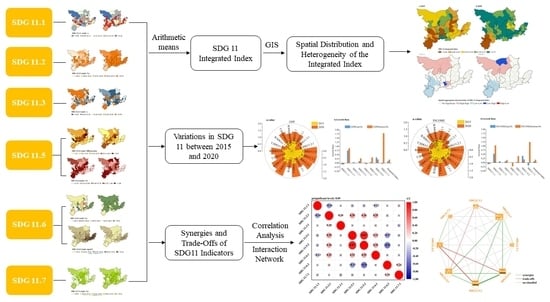Assessing Progress and Interactions toward SDG 11 Indicators Based on Geospatial Big Data at Prefecture-Level Cities in the Yellow River Basin between 2015 and 2020
Abstract
1. Introduction
2. Materials and Methods
2.1. Study Area
2.2. Data Sources
2.3. Methods
2.3.1. Calculation of the Integrated Index
2.3.2. Spatial Autocorrelation Analysis
- (1)
- Global Moran’s I
- (2)
- Local Moran’s I
2.3.3. Correlation Analysis
3. Results
3.1. Spatial Distribution Patterns of Indicators
- (1)
- Housing Affordability Index (SDG 11.1.1)
- (2)
- Proportion of the population that has convenient access to public transport (SDG 11.2.1)
- (3)
- Ratio of land consumption rate to the population growth rate (SDG 11.3.1)
- (4)
- Urban disasters (SDG 11.5)
- (5)
- Urban environmental impact (SDG 11.6)
- (6)
- Average share of the built-up area of cities that is open space for public use for all (SDG 11.7.1)
3.2. Spatial Distribution and Heterogeneity of the Integrated Index
3.3. Variations in SDG 11 between 2015 and 2020
3.3.1. Differences in SDG 11 for GDP and Disposable Income Groups
3.3.2. SDG 11 Progress between 2015 and 2020
3.4. Synergies and Trade-Offs of SDG11 Indicators
4. Discussion
4.1. Policy Suggestions for Promoting Urban Sustainable Development
4.2. Future Research Directions
5. Conclusions
- (1)
- At the watershed scale, except for SDG 11.1.1, the performance of the integrated index and seven indicators improved from 2015 to 2020. The seven indicators and integrated index that improved in order of greatest to least were SDG 11.6.2, SDG 11.2.1, SDG 11.6.1, integrated index, SDG 11.5.1, SDG 11.7.1, SDG 11.3.1, and SDG 11.5.2. Specifically, the changes in SDG 11 indicators and integrated index at the prefecture-level cities showed similar dynamics as those at the watershed level;
- (2)
- In terms of GDP groups, the top 10 cities had higher values, whereas the bottom 10 cities experienced greater growth rates in the integrated index, SDG 11.2.1, SDG 11.5.1, and SDG 11.6.1. However, SDG 11.3.1 and SDG 11.6.2 are the opposite. Although the average value of SDG 11.1.1 in the top 10 cities was greater than in the bottom 10 cities, their growth rates were negative. Finally, SDG 11.5.2 and SDG 11.7.1 had higher values in the top 10 cities, but the growth rates of the two groups were the opposite;
- (3)
- In the matter of income levels, the top 10 and the bottom 10 groups had almost equal values of the integrated index, SDG 11.1.1, SDG 11.3.1, and SDG 11.7.1, whereas their growth rates were not the same case. Then, the top 10 cities group had higher values than the bottom 10 ones in SDG 11.2.1, SDG 11.5.1, and SDG 11.6.1, whereas the case of their growth rates was just the opposite. The values’ sequence in SDG 11.5.2 for both groups was the same as before, but the growth rates for them were negative. In addition, the value of the top 10 cities group lagged behind the bottom 10 but the former had a higher growth rate than the latter in SDG 11.6.2;
- (4)
- In general, among SDG 11 indicators in the Yellow River Basin, the synergies were greater than the trade-offs. To be specific, at a 0.05 significance level, there were eight pairs of indicators with synergies and four pairs with trade-offs. In addition, the most positive effects were embodied in SDG 11.2.1, whereas the trade-offs were mainly manifested in SDG 11.1.1 and SDG 11.6.2.
Author Contributions
Funding
Acknowledgments
Conflicts of Interest
Nomenclature
| HAI | Housing affordability index |
| ICSU | International Council for Science |
| LCRPGR | Ratio of land consumption rate to population growth rate |
| PIR | Price-to-income ratio |
| RIR | Rent-to-income ratio |
| SDG 11 | Sustainable Development Goal 11 |
| SDGs | Sustainable Development Goals |
| SDSN | Sustainable Development Solutions Network |
| the 2030 Agenda | The 2030 Agenda for Sustainable Development |
| UN | United Nations |
References
- Elmqvist, T.; Andersson, E.; Frantzeskaki, N.; McPhearson, T.; Olsson, P.; Gaffney, O.; Takeuchi, K.; Folke, C. Sustainability and resilience for transformation in the urban century. Nat. Sustain. 2019, 2, 267–273. [Google Scholar] [CrossRef]
- United Nations. The Sustainable Development Goals Report 2020. 2020. Available online: https://unstats.un.org/sdgs/report/2020/ (accessed on 31 May 2021).
- Chinese Academy of Sciences. Big Earth Data in Support of the Sustainable Development Goals 2021. 2021. Available online: http://www.cbas.ac.cn/yjcg/yjbg/202109/P020210928347353712595.pdf (accessed on 8 January 2022).
- Chen, R.; Zhao, Z.; Xu, D.; Chen, Y. Progress of research on sustainable development index for cities and urban agglomerations. Prog. Geogr. 2021, 40, 61–72. [Google Scholar] [CrossRef]
- United Nations General Assembly. Transforming Our World: The 2030 Agenda for Sustainable Development. 2015. Available online: https://undocs.org/en/A/RES/70/1 (accessed on 16 April 2022).
- Pradhan, P.; Costa, L.; Rybski, D.; Lucht, W.; Kropp, J.P. A Systematic Study of Sustainable Development Goal (SDG) Interactions. Earth’s Future 2017, 5, 1169–1179. [Google Scholar] [CrossRef]
- Jiang, H.; Sun, Z.; Guo, H.; Weng, Q.; Du, W.; Xing, Q.; Cai, G. An assessment of urbanization sustainability in China between 1990 and 2015 using land use efficiency indicators. npj Urban Sustain. 2021, 1, 1–13. [Google Scholar] [CrossRef]
- Wang, Y.; Huang, C.; Feng, Y.; Zhao, M.; Gu, J. Using Earth Observation for Monitoring SDG 11.3.1-Ratio of Land Consumption Rate to Population Growth Rate in Mainland China. Remote. Sens. 2020, 12, 357. [Google Scholar] [CrossRef]
- Lusseau, D.; Mancini, F. Income-based variation in Sustainable Development Goal interaction networks. Nat. Sustain. 2019, 2, 242–247. [Google Scholar] [CrossRef]
- Guo, H.; Liang, D.; Sun, Z.; Chen, F.; Wang, X.; Li, J.; Zhu, L.; Bian, J.; Wei, Y.; Huang, L.; et al. Measuring and evaluating SDG indicators with Big Earth Data. Sci. Bull. 2022, 67, 1792–1801. [Google Scholar] [CrossRef]
- Sachs, J.; Schmidt-Traub, G.; Kroll, C.; Lafortune, G.; Fuller, G. Sustainable Development Report 2019. 2019. Available online: https://www.sdgindex.org/reports/sustainable-development-report-2019/ (accessed on 28 March 2020).
- Sachs, J.; Schmidt-Traub, G.; Kroll, C.; Lafortune, G.; Fuller, G.; Woelm, F. The Sustainable Development Goals and COVID-19: Sustainable Development Report 2020. 2020. Available online: https://www.sdgindex.org/reports/sustainable-development-report-2020/ (accessed on 22 February 2022).
- Sachs, J.; Kroll, C.; Lafortune, G.; Fuller, G.; Woelm, F. The Decade of Action for the Sustainable Development Goals: Sustainable Development Report 2021. 2021. Available online: https://www.sdgindex.org/ (accessed on 22 February 2022).
- Xu, Z.; Chau, S.N.; Chen, X.; Zhang, J.; Li, Y.; Dietz, T.; Wang, J.; Winkler, J.A.; Fan, F.; Huang, B.; et al. Assessing progress towards sustainable development over space and time. Nature 2020, 577, 74–78. [Google Scholar] [CrossRef]
- Fu, B.; Zhang, J.; Wang, S.; Zhao, W. Classification–coordination–collaboration: A systems approach for advancing Sustainable Development Goals. Natl. Sci. Rev. 2020, 7, 838–840. [Google Scholar] [CrossRef]
- Friedman, J.; York, H.; Graetz, N.; Woyczynski, L.; Whisnant, J.; Hay, S.I.; Gakidou, E. Measuring and forecasting progress towards the education-related SDG targets. Nature 2020, 580, 636–639. [Google Scholar] [CrossRef]
- Sciarra, C.; Chiarotti, G.; Ridolfi, L.; Laio, F. A network approach to rank countries chasing sustainable development. Sci. Rep. 2021, 11, 15441. [Google Scholar] [CrossRef] [PubMed]
- Huan, Y.; Li, H.; Liang, T. A New Method for the Quantitative Assessment of Sustainable Development Goals (SDGs) and a Case Study on Central Asia. Sustainability 2019, 11, 3504. [Google Scholar] [CrossRef]
- D’Adamo, I.; Gastaldi, M.; Imbriani, C.; Morone, P. Assessing regional performance for the Sustainable Development Goals in Italy. Sci. Rep. 2021, 11, 24117. [Google Scholar] [CrossRef] [PubMed]
- Huan, Y.; Liang, T.; Li, H.; Zhang, C. A systematic method for assessing progress of achieving sustainable development goals: A case study of 15 countries. Sci. Total Environ. 2021, 752, 141875. [Google Scholar] [CrossRef] [PubMed]
- Simon, D.; Arfvidsson, H.; Anand, G.; Bazaz, A.; Fenna, G.; Foster, K.; Jain, G.; Hansson, S.; Evans, L.M.; Moodley, N.; et al. Developing and testing the Urban Sustainable Development Goal’s targets and indicators—A five-city study. Environ. Urban. 2016, 28, 49–63. [Google Scholar] [CrossRef]
- Akuraju, V.; Pradhan, P.; Haase, D.; Kropp, J.P.; Rybski, D. Relating SDG11 indicators and urban scaling—An exploratory study. Sustain. Cities Soc. 2020, 52, 101853. [Google Scholar] [CrossRef]
- Steiniger, S.; Wagemann, E.; de la Barrera, F.; Molinos-Senante, M.; Villegas, R.; de la Fuente, H.; Vives, A.; Arce, G.; Herrera, J.-C.; Carrasco, J.-A.; et al. Localising urban sustainability indicators: The CEDEUS indicator set, and lessons from an expert-driven process. Cities 2020, 101, 102683. [Google Scholar] [CrossRef]
- Huang, C.; Sun, Z.; Jiang, H.; Wang, J.; Wang, P.; Tao, J.; Liu, H.; Liu, N. Big Earth Data Supports Sustainable Cities and Communities: Progress and Challenges. Bull. Chin. Acad. Sci. 2021, 36, 9. [Google Scholar] [CrossRef]
- Zhang, C.; Sun, Z.; Xing, Q.; Sun, J.; Xia, T.; Yu, H. Localizing Indicators of SDG11 for an Integrated Assessment of Urban Sustainability—A Case Study of Hainan Province. Sustainability 2021, 13, 11092. [Google Scholar] [CrossRef]
- Jiang, H.; Guo, H.; Sun, Z.; Xing, Q.; Zhang, H.; Ma, Y.; Li, S. Projections of urban built-up area expansion and urbanization sustainability in China’s cities through 2030. J. Clean. Prod. 2022, 367, 133086. [Google Scholar] [CrossRef]
- UN-Water. Water and Sanitation Interlinkages across the 2030 Agenda for Sustainable Development. 2016. Available online: https://www.unwater.org/publications/water-sanitation-interlinkages-across-2030-agenda-sustainable-development/ (accessed on 10 April 2020).
- Bleischwitz, R.; Spataru, C.; VanDeveer, S.D.; Obersteiner, M.; van der Voet, E.; Johnson, C.; Andrews-Speed, P.; Boersma, T.; Hoff, H.; van Vuuren, D.P. Resource nexus perspectives towards the United Nations Sustainable Development Goals. Nat. Sustain. 2018, 1, 737–743. [Google Scholar] [CrossRef]
- Fuso Nerini, F.; Tomei, J.; To, L.S.; Bisaga, I.; Parikh, P.; Black, M.; Borrion, A.; Spataru, C.; Castán Broto, V.; Anandarajah, G.; et al. Mapping synergies and trade-offs between energy and the Sustainable Development Goals. Nat. Energy 2018, 3, 10–15. [Google Scholar] [CrossRef]
- Fuso Nerini, F.; Sovacool, B.; Hughes, N.; Cozzi, L.; Cosgrave, E.; Howells, M.; Tavoni, M.; Tomei, J.; Zerriffi, H.; Milligan, B. Connecting climate action with other Sustainable Development Goals. Nat. Sustain. 2019, 2, 674–680. [Google Scholar] [CrossRef]
- Nilsson, M.; Griggs, D.; Visbeck, M. Policy: Map the interactions between Sustainable Development Goals. Nature 2016, 534, 320–322. [Google Scholar] [CrossRef] [PubMed]
- International Council for Science (ICSU). A Guide to SDG Interactions: From Science to Implementation; Griggs, D.J., Nilsson, M., Stevance, A., McCollum, S., Eds.; International Council for Science: Paris, France, 2017. [Google Scholar]
- Mainali, B.; Luukkanen, J.; Silveira, S.; Kaivo-oja, J. Evaluating Synergies and Trade-Offs among Sustainable Development Goals (SDGs): Explorative Analyses of Development Paths in South Asia and Sub-Saharan Africa. Sustainability 2018, 10, 815. [Google Scholar] [CrossRef]
- Zhou, X.; Moinuddin, M.; Xu, M. Sustainable Development Goals Interlinkages and Network Analysis: A Practical Tool for SDG Integration and Policy Coherence. 2017. Available online: https://www.iges.or.jp/en/pub/sustainable-development-goals-interlinkages/en (accessed on 10 April 2020).
- Bain, P.G.; Kroonenberg, P.M.; Johansson, L.-O.; Milfont, T.L.; Crimston, C.R.; Kurz, T.; Bushina, E.; Calligaro, C.; Demarque, C.; Guan, Y.; et al. Public views of the Sustainable Development Goals across countries. Nat. Sustain. 2019, 2, 819–825. [Google Scholar] [CrossRef]
- de Miguel Ramos, C.; Laurenti, R. Synergies and Trade-offs among Sustainable Development Goals: The Case of Spain. Sustainability 2020, 12, 10506. [Google Scholar] [CrossRef]
- Dawes, J.H.P. SDG interlinkage networks: Analysis, robustness, sensitivities, and hierarchies. World Dev. 2022, 149, 105693. [Google Scholar] [CrossRef]
- Thacker, S.; Adshead, D.; Fay, M.; Hallegatte, S.; Harvey, M.; Meller, H.; O’Regan, N.; Rozenberg, J.; Watkins, G.; Hall, J.W. Infrastructure for sustainable development. Nat. Sustain. 2019, 2, 324–331. [Google Scholar] [CrossRef]
- Hinz, R.; Sulser, T.B.; Huefner, R.; Mason-D’Croz, D.; Dunston, S.; Nautiyal, S.; Ringler, C.; Schuengel, J.; Tikhile, P.; Wimmer, F.; et al. Agricultural Development and Land Use Change in India: A Scenario Analysis of Trade-Offs Between UN Sustainable Development Goals (SDGs). Earth’s Future 2020, 8, e2019EF001287. [Google Scholar] [CrossRef]
- Bisaga, I.; Parikh, P.; Tomei, J.; To, L.S. Mapping synergies and trade-offs between energy and the sustainable development goals: A case study of off-grid solar energy in Rwanda. Energy Policy 2021, 149, 112028. [Google Scholar] [CrossRef]
- Wang, M.; Janssen, A.B.G.; Bazin, J.; Strokal, M.; Ma, L.; Kroeze, C. Accounting for interactions between Sustainable Development Goals is essential for water pollution control in China. Nat. Commun. 2022, 13, 730. [Google Scholar] [CrossRef]
- Yellow River Conservancy Commission. Huanghe Nianjian; Yellow River Yearbook Press: Zhengzhou, China, 2021. [Google Scholar] [CrossRef]
- Zhai, T.; Zhang, D.; Zhao, C. How to optimize ecological compensation to alleviate environmental injustice in different cities in the Yellow River Basin? A case of integrating ecosystem service supply, demand and flow. Sustain. Cities Soc. 2021, 75, 103341. [Google Scholar] [CrossRef]
- OECD; European Commission; JRC. Handbook on Constructing Composite Indicators_Methodology and User Guide; OECD Publishing: Paris, France, 2008. [Google Scholar] [CrossRef]
- Li, X.; Cao, C.; Chang, C. The First Law of Geography and Spatial-Temporal Proximity. Chin. J. Nat. 2007, 29, 69–71. [Google Scholar]
- Tobler, W.R. A Computer Movie Simulating Urban Growth in the Detroit Region. Econ. Geogr. 1970, 46, 234–240. [Google Scholar] [CrossRef]
- Anselin, L. Local Indicators of Spatial Association-LISA. Geogr. Anal. 1995, 27, 93–115. [Google Scholar] [CrossRef]
- De Winter, J.C.; Gosling, S.D.; Potter, J. Comparing the Pearson and Spearman correlation coefficients across distributions and sample sizes: A tutorial using simulations and empirical data. Psychol. Methods 2016, 21, 273–290. [Google Scholar] [CrossRef] [PubMed]
- Hauke, J.; Kossowski, T. Comparison of Values of Pearson’s and Spearman’s Correlation Coefficients on the Same Sets of Data. Quageo 2011, 30, 87–93. [Google Scholar] [CrossRef]
- United Nations Statistics Division. SDG Indicator Metadata-11.7.1. 2021. Available online: https://unstats.un.org/sdgs/metadata/ (accessed on 28 April 2022).
- Jiang, H. Study on the Coupling Coordination between Economic Development and Ecological Environment Protection in Cities along the Yellow River Basin; Zhengzhou University of Light Industry: Zhengzhou, China, 2022. [Google Scholar]
- Zhou, Q. Impact Mechanism of Environmental Regulation on High-Quality Development of the Yellow River Basin; Northwest University: Xi’an, China, 2021. [Google Scholar]
- Wu, X.; Fu, B.; Wang, S.; Song, S.; Li, Y.; Xu, Z.; Wei, Y.; Liu, J. Decoupling of SDGs followed by re-coupling as sustainable development progresses. Nat. Sustain. 2022, 5, 452–459. [Google Scholar] [CrossRef]
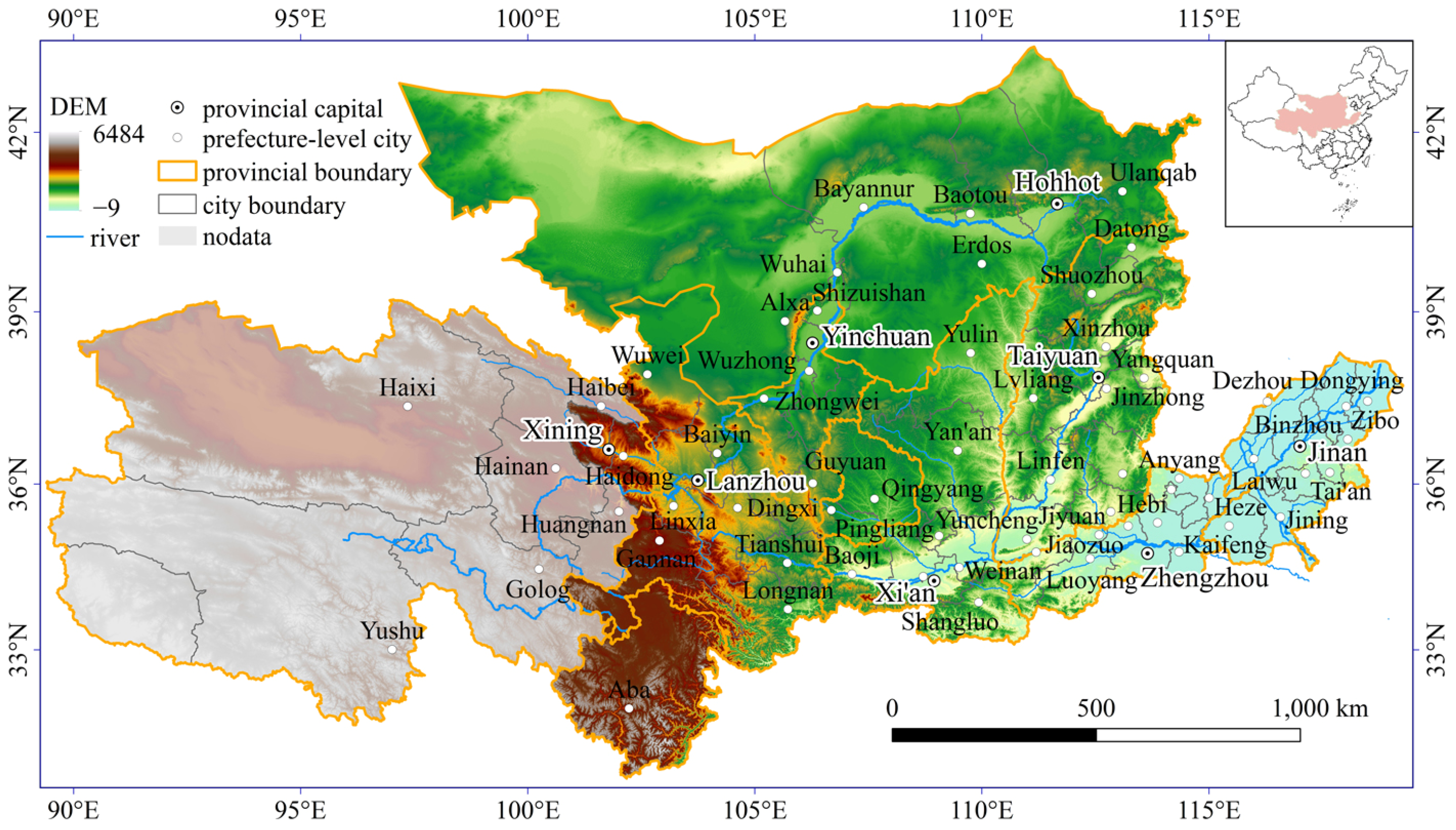
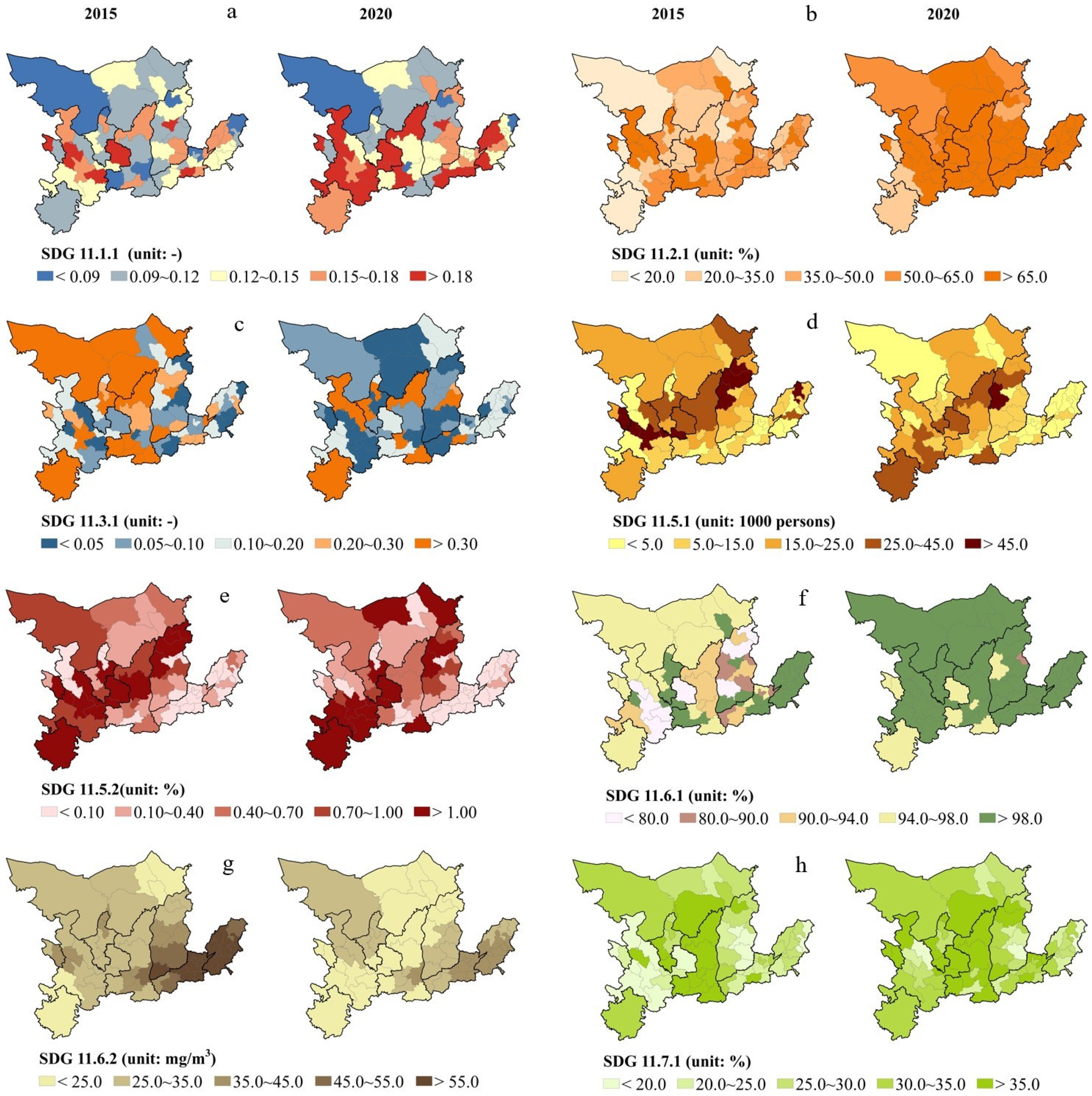
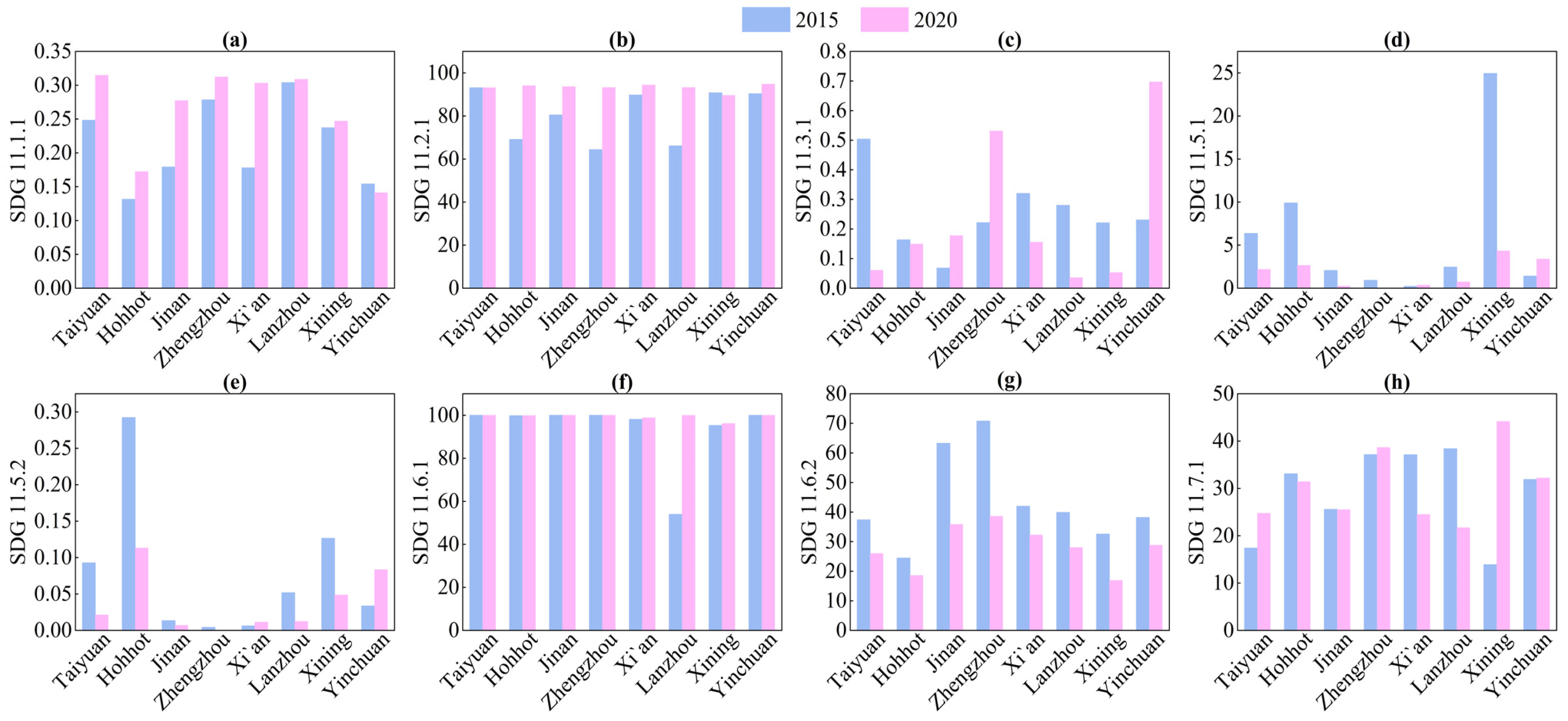
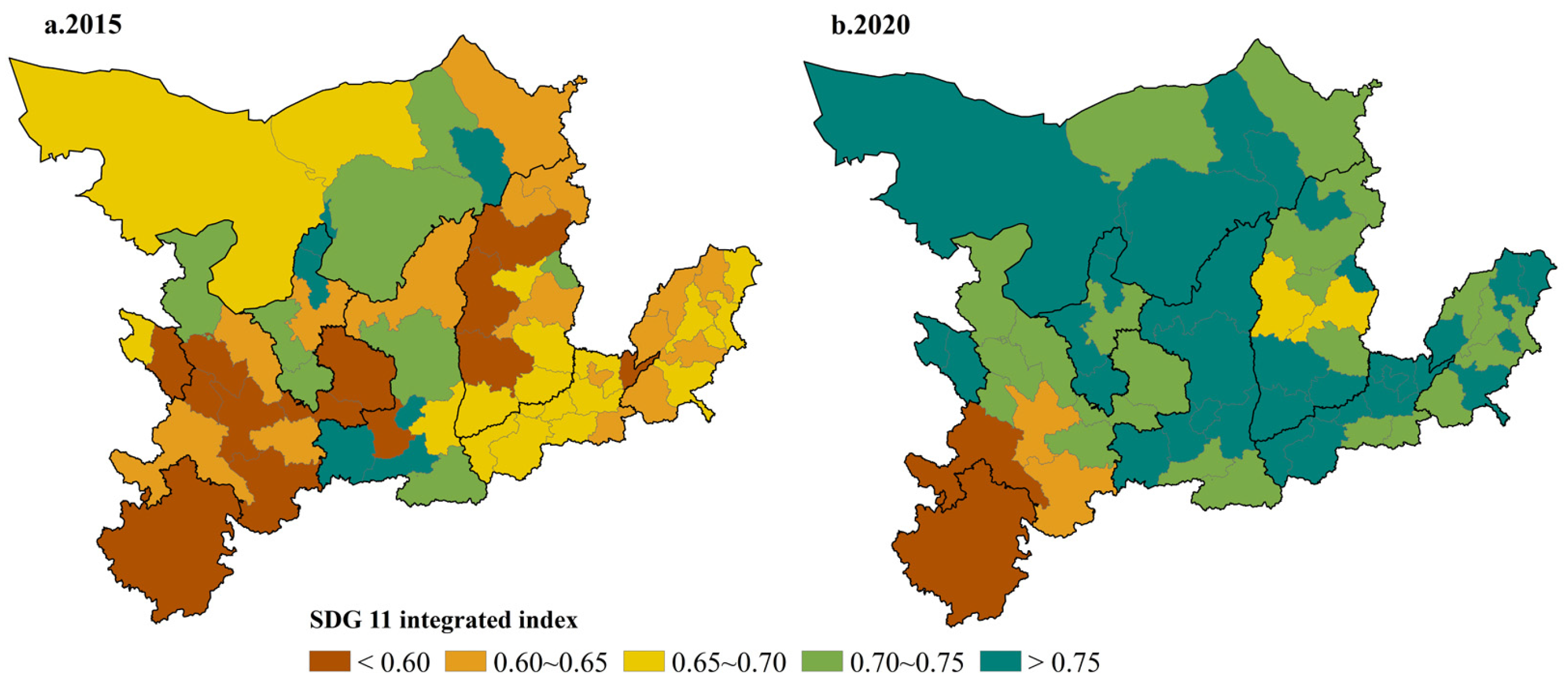

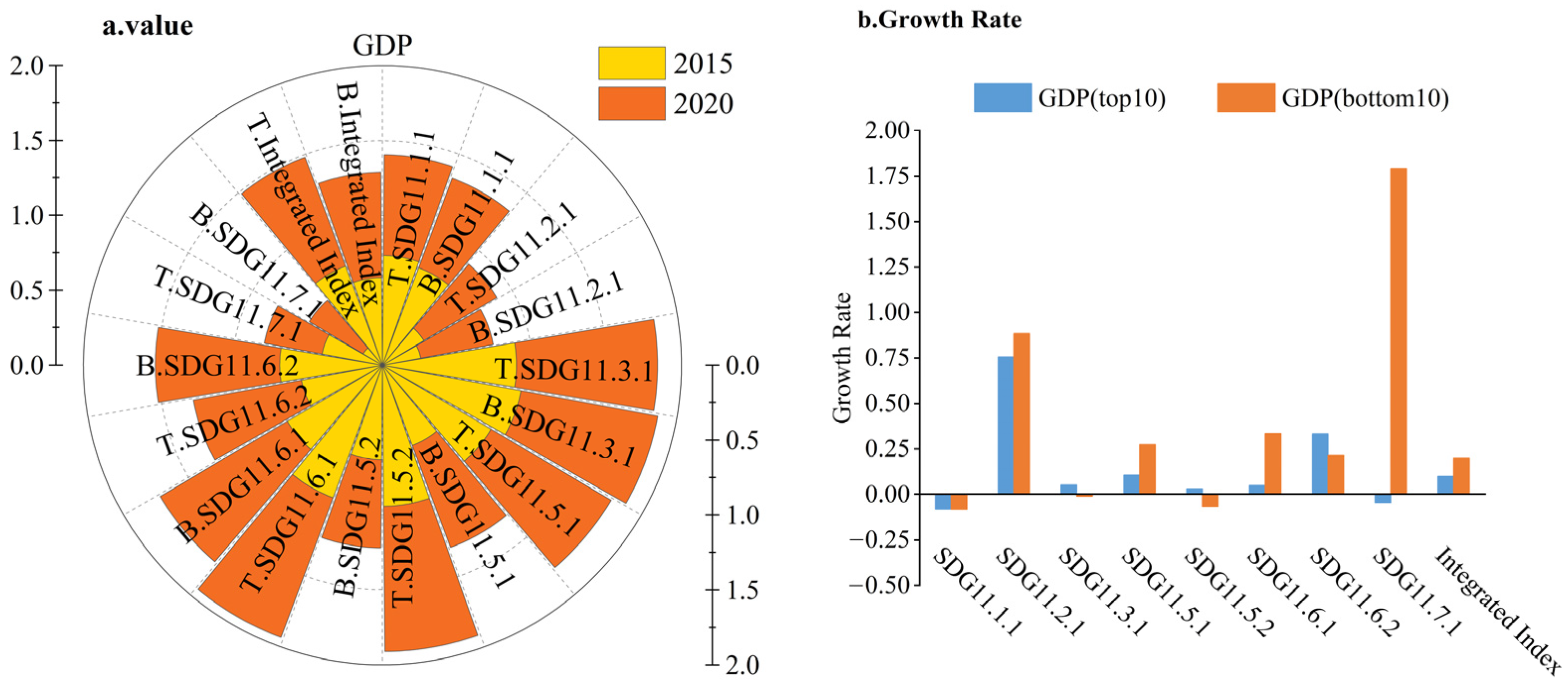
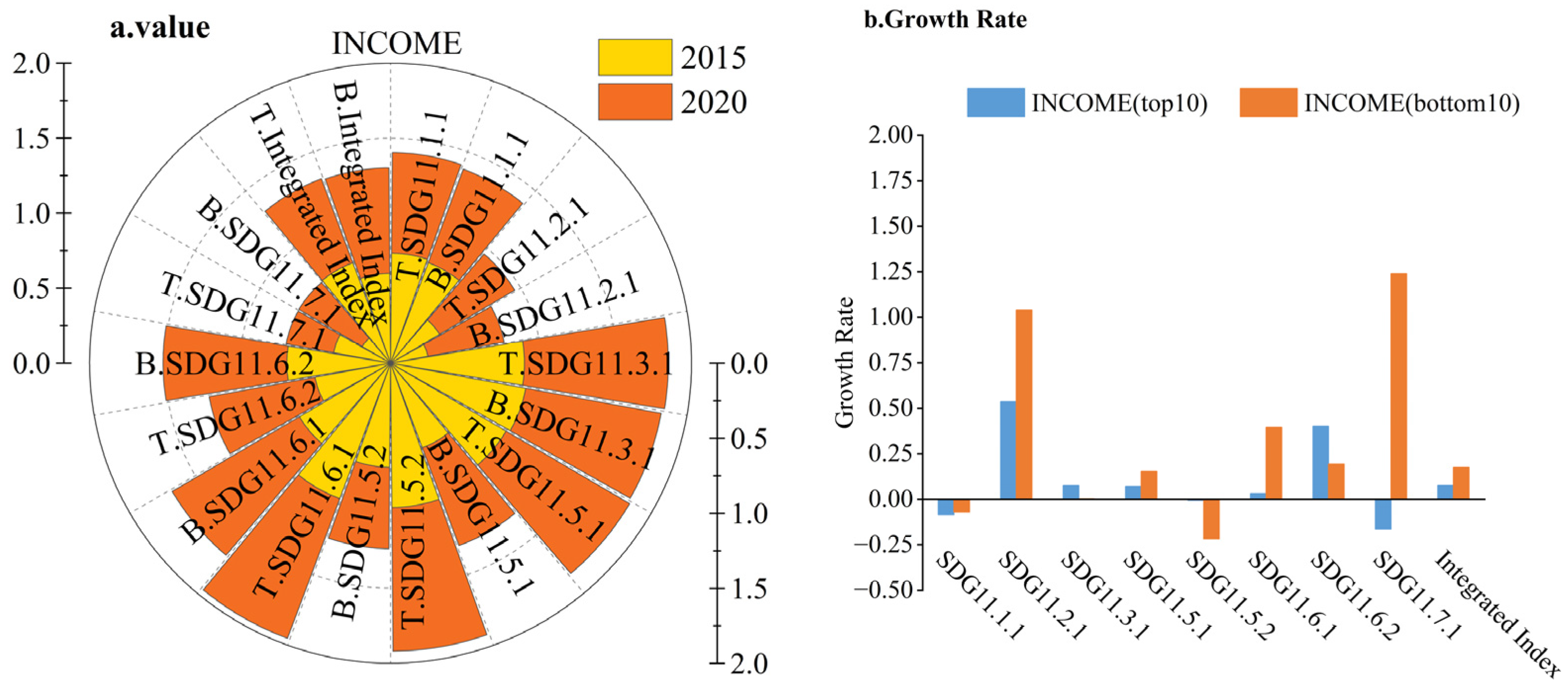
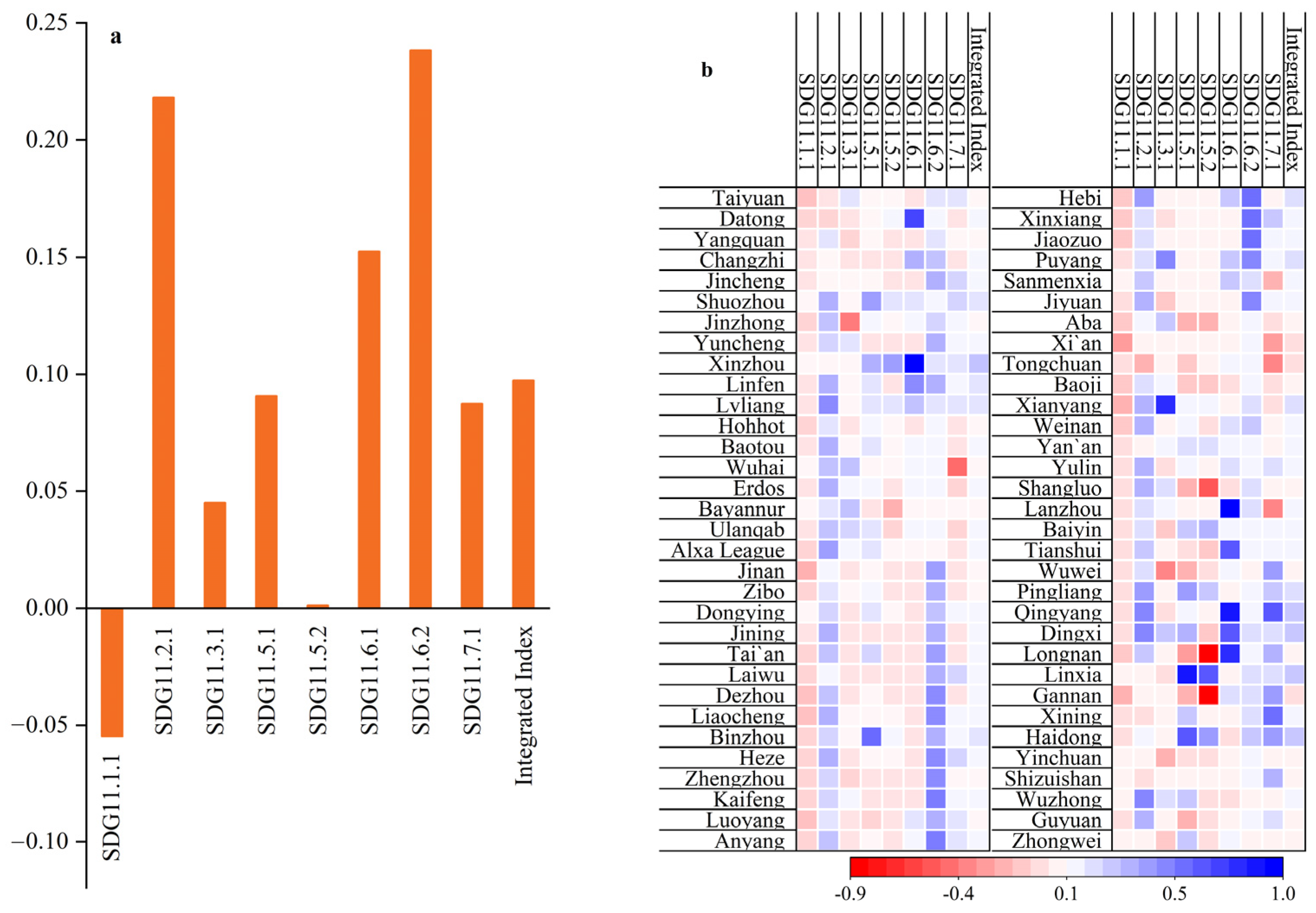
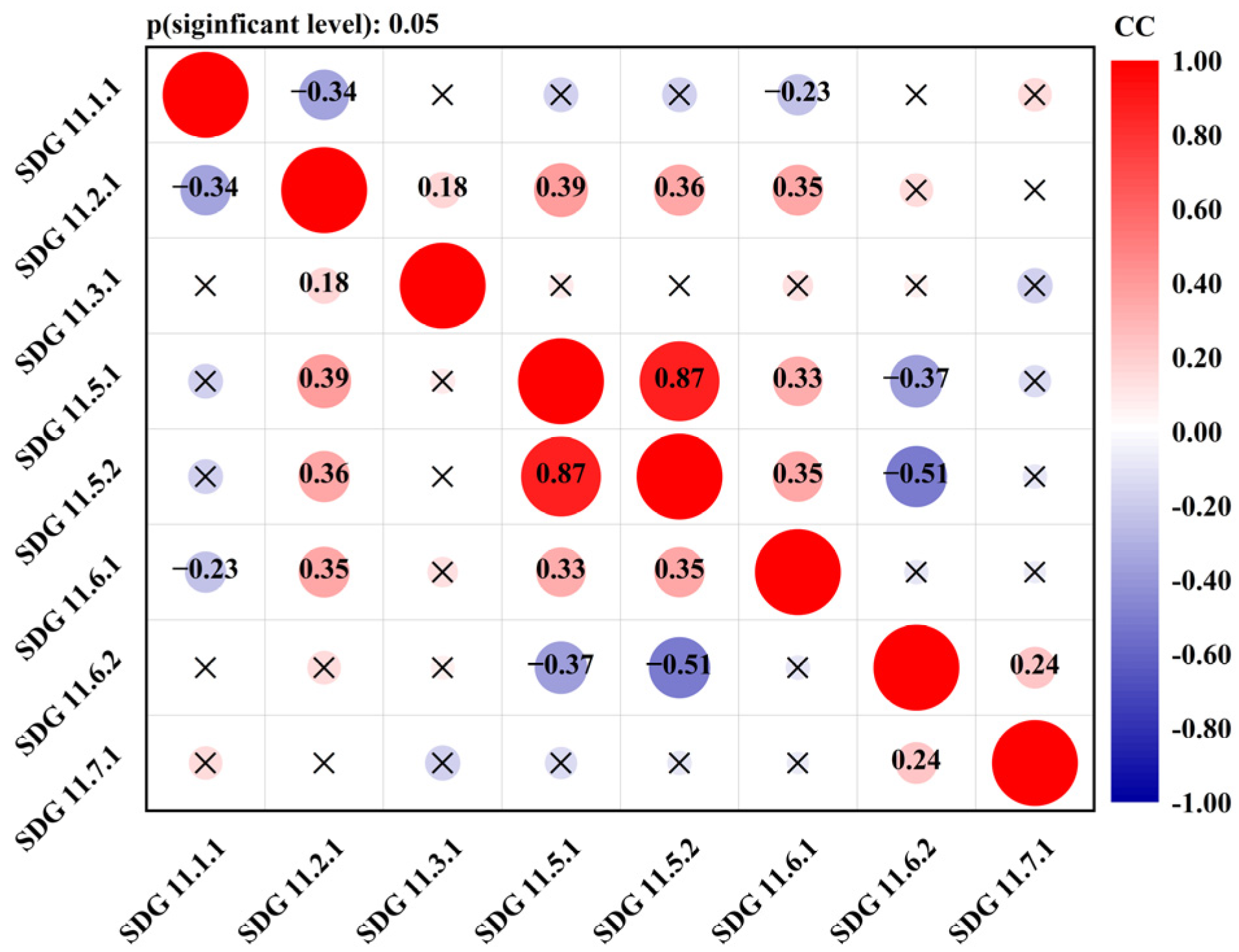
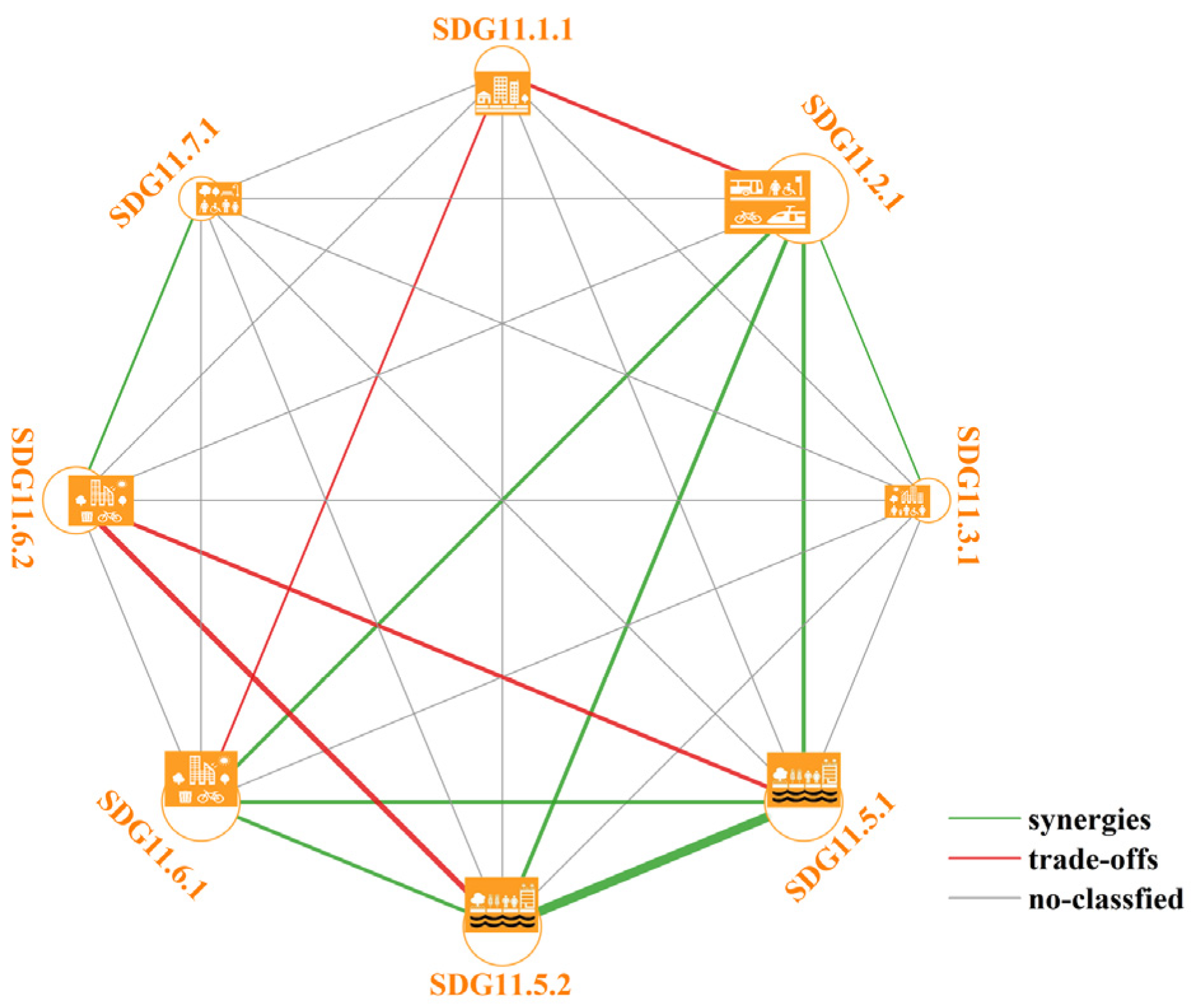
| Authors | Time | Research Priorities | Methods | Region |
|---|---|---|---|---|
| ||||
| SDSN [11,12,13] | 2019–2021 | Assessed the SDG index and dashboards of the 17 SDGs for every country in the world. | Arithmetic means | World |
| Xu et al. [14] | 2020 | Calculated the SDG index for the national scale and provincial-level administrative division of China. | Arithmetic means | Country, Province |
| Sciarra et al. [17] | 2021 | Calculated the SDG index to rank countries for their achievements. | Network science | World |
| ||||
| Huan et al. [18] | 2019 | Assessed the SDGs scores and analyzed the SDGs performance of Kazakhstan and Kyrgyzstan. | Arithmetic means, Chow Test | Country |
| D’Adamo et al. [19] | 2021 | Discussed the progress of SDGs in Italy under two scenarios of equal weight for indicators and goals, respectively. | Arithmetic means, MCDA | Country Region |
| Huan et al. [20] | 2021 | Assessed the progress of achieving SDGs in 15 countries along the “Belt and Road”. | Composite SDG index | Country |
| ||||
| Simon et al. [21] | 2016 | Put forward 10 principles for the evaluation of international cities’ sustainable development based on SDG11. | Qualitative research | City |
| Akuraju et al. [22] | 2020 | Explored the relationships between countrywide SDG11 indicators and urban scaling exponents. | Linear regression | City |
| Wang et al. [8] | 2020 | Evaluated urbanization sustainability by monitoring SDG 11.3.1 between 1990 and 2010 in mainland China. | Spatial analysis | City |
| Chen et al. [4] | 2021 | Put forward the methodology of constructing the sustainable development index of cities and urban agglomerations and the idea of establishing the “dashboard” of urban development. | Qualitative research | City |
| Huang et al. [24] | 2021 | Monitoring the progress of SDG 11 indicators and proposing some challenges that currently exist. | Arithmetic means | Country |
| Zhang et al. [25] | 2021 | Localized the SDG 11 indicators and integrated assessment of SDG 11 indicators in Hainan Province. | Arithmetic means | City County |
| Jiang et al. [7] | 2021 | Assessing urbanization sustainability in China by comparing the relationship between land, population, and economic urbanization. | Spatial analysis | City |
| Jiang et al. [26] | 2022 | Projected urbanization sustainability in 2020–2030 under the Shared Socioeconomic Pathways (SSPs). | An integrated downscaling approach of trend extrapolation and regression analysis | Province |
| Target | Indicator | Data Sources |
|---|---|---|
| 11.1 Housing | 11.1.1 Proportion of urban population living in slums, informal settlements, or inadequate housing | Housing Affordability Index |
| 11.2 Convenient access to public transport | 11.2.1 Proportion of the population that has convenient access to public transport, by sex, age and persons with disabilities | Public transportation information data |
| 11.3 Urbanization | 11.3.1 Ratio of land consumption rate to the population growth rate | Land consumption rate; Population growth rate |
| 11.5 Urban disasters | 11.5.1 Number of deaths, missing persons, and directly affected persons attributed to disasters per 100,000 population | Hazard data |
| 11.5.2 Direct economic loss in relation to global GDP, damage to critical infrastructure, and number of disruptions to basic services, attributed to disasters | Hazard data | |
| 11.6 Environmental impact | 11.6.1 Proportion of urban solid waste regularly collected and with adequate final discharge out of total urban solid waste generated, by cities | Rate of domestic garbage harmless treatment |
| 11.6.2 Annual mean levels of fine particulate matter (e.g., PM2.5 and PM10) in cities (population weighted) | Annual average PM2.5 | |
| 11.7 Open public space | 11.7.1 Average share of the built-up area of cities that is open space for public use for all, by sex, age, and persons with disabilities | Public space data |
Disclaimer/Publisher’s Note: The statements, opinions and data contained in all publications are solely those of the individual author(s) and contributor(s) and not of MDPI and/or the editor(s). MDPI and/or the editor(s) disclaim responsibility for any injury to people or property resulting from any ideas, methods, instructions or products referred to in the content. |
© 2023 by the authors. Licensee MDPI, Basel, Switzerland. This article is an open access article distributed under the terms and conditions of the Creative Commons Attribution (CC BY) license (https://creativecommons.org/licenses/by/4.0/).
Share and Cite
Feng, Y.; Huang, C.; Song, X.; Gu, J. Assessing Progress and Interactions toward SDG 11 Indicators Based on Geospatial Big Data at Prefecture-Level Cities in the Yellow River Basin between 2015 and 2020. Remote Sens. 2023, 15, 1668. https://doi.org/10.3390/rs15061668
Feng Y, Huang C, Song X, Gu J. Assessing Progress and Interactions toward SDG 11 Indicators Based on Geospatial Big Data at Prefecture-Level Cities in the Yellow River Basin between 2015 and 2020. Remote Sensing. 2023; 15(6):1668. https://doi.org/10.3390/rs15061668
Chicago/Turabian StyleFeng, Yaya, Chunlin Huang, Xiaoyu Song, and Juan Gu. 2023. "Assessing Progress and Interactions toward SDG 11 Indicators Based on Geospatial Big Data at Prefecture-Level Cities in the Yellow River Basin between 2015 and 2020" Remote Sensing 15, no. 6: 1668. https://doi.org/10.3390/rs15061668
APA StyleFeng, Y., Huang, C., Song, X., & Gu, J. (2023). Assessing Progress and Interactions toward SDG 11 Indicators Based on Geospatial Big Data at Prefecture-Level Cities in the Yellow River Basin between 2015 and 2020. Remote Sensing, 15(6), 1668. https://doi.org/10.3390/rs15061668






